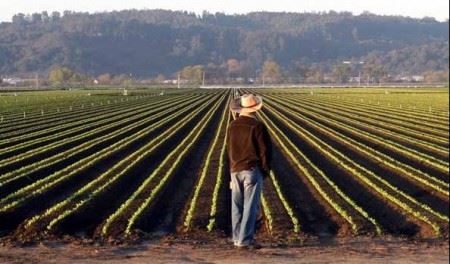Farm to Fork Column
By: Victor Martino
The Summer of Justifiable Discontent for California Farmers

Along with the normal day-to-day challenges farming presents, the summer of 2018 has been packed with serious, hot-button issues for farmers and agriculture as a whole in the Golden State.
There are three big issues farmers in California are grappling with the most as we enter the dog days of summer in September: immigration reform, President Trump’s trade wars, and water regulation.
Immigration reform
President Trump’s immigration reform policy is being felt by growers and producers throughout California, particularly those in the specialty agriculture sector who rely the most on immigrant farm workers to pick their crops.
Put simply, California agriculture is experiencing a real and pronounced labor shortage.
For example, there have been cases of crops not being picked because of a lack of workers to pick them, some farmers are talking about fallowing land if the situation gets worse, and although great strides are being made in precision agriculture (agtech for short), the reality is there isn’t a technology ready for prime time yet that can replace much of the work humans do, such as picking crops.
To date farm county members of Congress have been able to do little to help with the problem.
President Trump has made clear he plans to move forward with strict immigration rules with Mexico, which is the source of most of the seasonal farm workers in California, just like he said he would do during his 2016 campaign.
Even if one agrees with his policy, it’s only honest to acknowledge that right now it’s having a negative effect on farming in California.
Solutions are lacking. Talk of a guest-worker program comes and goes, for example. But Congress and the President aren’t addressing the issue from a public policy standpoint. As a result, farmers and agriculture are the losers.
Additionally, even though it’s unlikely to ever happen, President Trump keeps calling for the construction of his wall on the border with Mexico, which only serves to fan the flames in labor-hungry California farm country.
The reality is California agriculture relies on immigrants from Mexico, many who come here illegally, to pick the crops we all enjoy eating.
Trade wars
The fact talks on renewing NAFTA have been stalled for months also has contributed to the labor shortage on California’s farms and in its fields.
Immigration reform and trade with Mexico are linked. And the relationship between the U.S. and Mexico has been at a near-historic low-point all year.
A NAFTA agreement is needed for a number of reasons, including the fact open two-way trade between the U.S. and Mexico is vital for California agriculture.
A deal also is needed because without it no compromise on immigration reform can be reached, if one can.
At this point Congress, including members of both parties from the state’s farm counties, is helpless to do anything because trade negotiations are in the hands of the president.
The Farm Bureau and other food and agriculture trade organizations have the ear of U.S. Agriculture Secretary Sonny Perdue, who himself is a farmer. However, his role in the NAFTA trade deal negotiations is at best a minor one.
President Trump’s trade wars with Canada, China and the European Union also have California farmers and the Golden State’s agribusiness industry extremely worried.
For example, the almond harvest is nearly here. Forecasts are for a record crop. China is the second-largest buyer of California-grown almonds. But it’s put a 50% tax on the crop, which will be reflected in higher prices in retail stores in China, possibly leading to a significant reduction in almond exports to the nation this year, unless the trade war comes to an end, which currently doesn’t look to be the case any time soon. The wholesale price for California almonds has fallen 10% since the Chinese announced the tariff.
Secretary of Agriculture Perdue visited California in mid-August, meeting with a number of farmers and farm groups.
Producers at the meetings told him they want export assistance as one way to help smooth the negative consequences of the trade wars. He didn’t commit to offering it but told them he would take their concerns back to the President.
Prior to Perdue’s mid-August trip to California, President Trump allocated $12 million in tariff relief aid for U.S. farmers. This is a one-time payment however and likely won’t amount to much of anything on a per-farmer basis. It’s different than the type of export assistance the farmers are calling for.
California farmers do need some type of export assistance if President Trump intends to continue and prolong his trade wars. What form that assistance should take and how much should be spent considering the U.S. budget deficit is ballooning is subject to debate.
But the fact is California agriculture is in the crosshairs of what was a political decision by the President to launch trade wars with multiple nations. As such, farmers and agriculture shouldn’t bear the brunt of what could end up being billions of dollars in lost exports for producers in the Golden State.
Water Regulation
This has also been a summer of real discontent for farmers when it comes to one of the most vexing and long-standing issues in California agriculture — water policy and regulation.
A plan released in late August by state regulators to re-divide the Tuolumne River and most of the rest of the lower San Joaquin River watershed has set-off one of the fiercest fights over water California has seen in many years.
The plan calls for leaving more of the water in the lower San Joaquin River and its three tributaries, the Tuolumne, Merced and Stanislaus. If passed, this will mean more water will flow out to the ocean.
The State Water Board says the increased flows would prevent an “ecological crisis” for fish. The problem is it will also leave less water for farmers and for about three million people who live in an area stretching from the San Francisco Bay Area to Stanislaus County in the San Joaquin Valley.
The new policy could have serious consequences for agriculture. Less water means less crops, particularly those that require enough water to thrive in the hot Central Valley sun.
It’s clear this new policy hasn’t been thought through very well by regulators. In fact, the City of San Francisco agrees with farmers in opposing it.
San Francisco, which gets its drinking water from the Hetch Hetchy Reservoir, has joined the Modesto and Turlock irrigation districts in proposing an alternative plan to revive the native fish populations, which is the rationale behind the State Water Board’s proposed changes.
The plan by the City of San Francisco and the two San Joaquin Valley irrigation districts is to reshape portions of the river to make them more conducive to salmon and less welcoming to non-native predator fish like bass that thrive in warm, slow-moving water.
Of the two alternatives, this plan would be far better for California’s farmers and the state’s massive agriculture industry. It’s also better for those 3 million people who live in the Bay Area and the Northern San Joaquin Valley.
The State Water Board doesn’t appear to be interested in the alternative plan though, which means the fight over water is only going to get worse.
Farming and food processing form the backbone of the Central Valley’s economy. The regulators don’t appear to be taking that reality into consideration with their plan. They need to go back to the drawing board. It’s not as simple as fish vs. people. But it’s pretty close.
California farmers have made great strides in water conservation — and are continuously improving. This move by regulators will cause too much hardship to California agriculture – and to farm county communities – and needs to be scrapped.
The summer of justifiable discontent looks like it’s going to extend into fall for California farmers. None of the three hot-button issues outlined above appear to have a near-term resolution in sight, although in late August there were some potentially promising signs regarding NAFTA, at least between the U.S. and Mexico. Canada remains a bigger problem.
The labor shortage threatens to bring serious consequences to farming in California if not addressed. At this point the only two rational solutions are a bipartisan immigration reform package – the only long-term solution – and a guest worker program. Neither of these solutions are likely this year though.
The water issue should be at a boiling point by the time you read this column. The Water Board was set to make a decision on its plan at the end of August, although I have a hunch they will kick the can down the road because there is so much controversy surrounding the plan.
There is a clear lack of consideration of the role farming and agriculture plays in California – and the nation – in the State Water Board’s thinking and action.
Abundance isn’t guaranteed
I often tell people that California agriculture and its sister food processing industry have been so successful in feeding the state, the country and the world, that most people simply take it for granted.
The abundance of food in our supermarkets. All the food wasted in restaurants and in homes. These realities of American life are indicative of taking for granted that our food supply will continue to be bountiful. It might not. And even if it does remain so, it could soon start costing consumers a lot more money to eat.
We’ve had a long era of abundant and cheap food in America. Don’t believe me? Ask a visiting European how prices at the grocery stores back home compare to the prices at California supermarkets. No contest. Advantage USA.
I suggest regulators and all of us think about this as a framework for all decisions that impact food and farming, including water policy.
Water is a limited and precious natural resource in California.
So why then do we allow so much of it to be used to water ornamental plants and lawns?
Why don’t we build more detention facilities to contain rain water?
And why don’t we have a real water policy, one that puts food (farming) and people (drinking water) first, with all other uses to follow?
The state’s regulators need to answer these questions and others.
It should be an interesting fall in the Golden State. Hopefully it will be better than the summer has been for California farmers.

By Victor Martino







